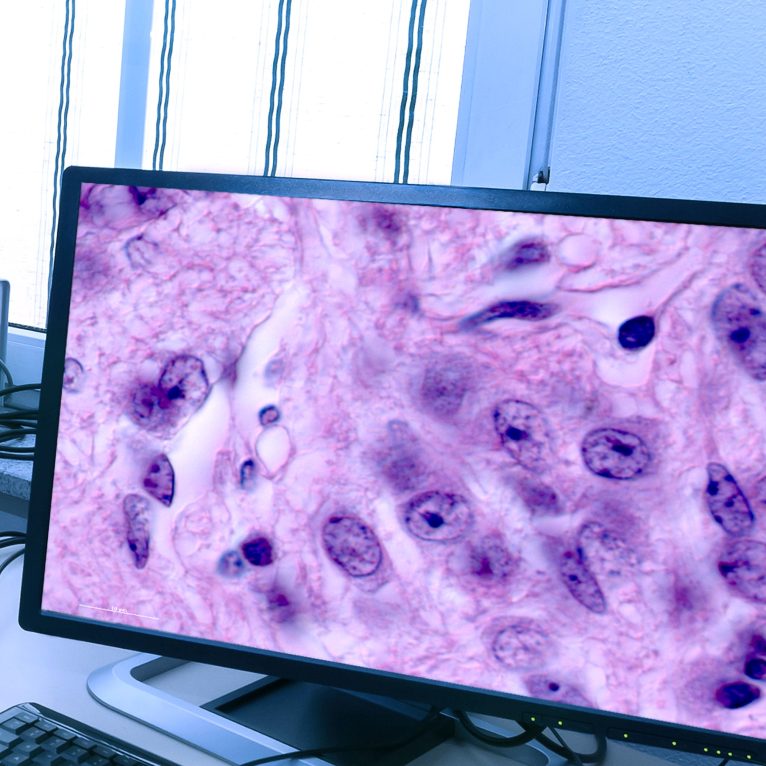
Written by

Cranfield, UK, 8th July 2024, Written by Imogen Fitt –
Hello everyone, for those who attended, I hope you had a great time at ECDP!
There were a few exciting announcements this month, and I’ve been busy interviewing >60 stakeholders in the DP ecosystem for Signify Research’s updated digital pathology report.
If you’d like to participate and share your perspectives on the market, do drop me a note! 😊
Below is June’s round-up for the digital pathology community (along with a few insights):
- Histofy and Indica Labs have partnered to share the former’s cellular AI algorithms on Indica’s IMS. The press release indicated that the two companies would be ‘aiming to seamlessly integrate’ Histofy’s AI tools, which are an AI-powered large bowel biopsy screening product and another for mitosis profiling. Indica labs also announced its the release of version 4.0 of HALO®, HALO AI, and HALO Link. Updates include optimised workflows, customisable analysis outputs and a compliance add-on for system-level auditing. Both announcements imply an increased focus on user experience, something the broader digital pathology industry is also focusing on. Post-COVID many new adopters started using digital workflows, and as organisations have incrementally increased usage of their platforms demand for more ergonomic and intuitive solutions is starting to emerge. As I’ve said before, the market is beginning to mature, and this is a great indicator for future growth.
- ZayaAI has announced the availability of a Pathology Laboratory Information System. Tight integration between the the digital pathology IMS and LIS is a growing pain-point for the industry as use scales in clinical settings. Unfortunately, many labs globally are working with outdated software which is not easy to interface with. Whilst many LIS vendors are now rolling out newer cloud-based modular products, the digital pathology industry is unfortunately held back in some instances as it waits for adjacent markets to catch up. For this reason, some functionalities historically performed by LIS are now being cannibalised by DP IMS. ZayaAI’s acquisition is another indication that the two markets are continuing to overlap. On a similar note, PreciPoint – Advanced Digital Pathology Solutions announced this month it has acquired Visonex (now Renvio) – a German LIS company. If you’re interested in learning more about the LIS market and its influence on digital pathology, Signify Research is set to publish an updated analysis on the market for both LIS (diagnostic, patient orientated software) and LIMS (non-diagnostic and more sample orientated lab settings) in September. For more information click here.
- Next, PathAI has announced two new AI products, PathExplore™ Immuno-Oncology Profiling (IOP) and IHC Explore1™. Both are designed to provide analyses of single-cell images of the tumour microenvironment. These can be used by customers to support biomarker discovery and the development of companion diagnostics with partners – but I’ll be interested to see if any of these projects have a digital product to commercialise once completed. Digital Companion Diagnostics (dCDx) was a popular trend amongst vendors developing AI products for image analysis in our recent ‘Digital Precision Medicine – World 2024‘ report. Interested in learning how precision medicine is shaping healthcare technology vendor and provider strategies? Message me for a complimentary overview of the study!
- HistoWiz has also announced further updates to its offerings as it expands the company’s histology and pathology service to include good laboratory practice (GLP). GLP is a quality system to ensure the quality and integrity of non-clinical laboratory studies. For pharma this relates to the required non-clinical animal testing that must be performed prior to human trials. HistoWiz stated that its customers included drug and vaccine development, cosmetics, and food and chemical safety companies. For those of you unfamiliar, HistoWiz would be classed as a ‘tele-pathology’ company in our upcoming topical, as it processes wet tissue but returns digital images on its online platform. Digital pathology in tele-pathology can be supplied in several ways, including offering ‘digitisation-as-a-service’. Our upcoming analysis will help to quantify the opportunity for digital pathology vendors in providing similar services.
- PharmaNest presented 7 digital pathology abstracts at one of its most recent conferences. All are evaluating the company’s FibroNest Ph-FCS digital biomarker for quantifying fibrosis severity, in particular for use in Phase 2 and Phase 3 studies for patients with Metabolic Associated Steatohepatitis (MASH). MASH is a very popular area of study for digital pathology which could have a great impact on the standard of care today. The first FDA-approved drug was only announced earlier this year, and pharma has been using digital pathology to support research into the condition. FibroNest offers single-fibre quantitative image analysis to help assess the severity and progression of fibrosis and inflammation.
- One announcement which got a lot of attention this month was that Roche received FDA 510(k) clearance for its VENTANA DP 200 scanner! The US market is growing very quickly according to my research and combined with recent announcement around LDT regulation it’s no wonder vendors have been keen to secure approvals. Competition will certainly heat up!
- Next on the list is Optiscan Imaging Ltd, which launched the InVue microscopic medical imaging device. The new device is designed specifically for surgical scenarios by providing real-time digital pathology access to surgeons. Under Signify Research’s definitions, digital pathology is specified by the ability to analyse whole slide images (WSI), however as the industry evolves more solutions like this are emerging. The company also referenced Optiscan’s cloud-based telepathology platform which according to the company will be launched next year. Interestingly, InVue is DICOM-compliant and PACS-enabled. Will the images be retained in practice? Likely not right away, today my research indicates quite a bit of deletion occurs in practice. However, this will place the company in good stead for the future, allowing better exchange of data when required.
- Ibex Medical Analytics announced that its platform is now live and in use at Alverno Laboratories. The launch is being phased in over an unspecified period of time (likely a number of years) and will eventually include Ibex’s prostate, breast and gastric products across the labs network in Illinois and Indiana. This comes after the two companies initially signed an agreement in 2023 – quite a long lead time to actual use!
- The second to last announcement that caught my eye this month was that Pathcore announced a strategic partnership with Instem where Pathcore will offer an integrated solution which automatically exchanges data between Provantis®, Instem’s preclinical data management solution and Pathcore’s PathcoreFlow image management system (IMS). Clinical is not the only market that requires tightly integrated systems! Lifesciences data management today suffers from many of the same problems around data siloes and efficient data management as healthcare…
- The final announcement that caught my eye is not exclusively digital pathology focused but Tempus AI successfully went public a few weeks ago. The company offers clinical services like digital pathology on top of providing third parties access to de-identified patient data hosted on its platform. Specifically, the company listed in its prospectus that although it had no direct competitors, it would compete with DPAI vendors such as Paige and PathAI, which is true. Tempus has so far developed algorithms based on Immunohistochemistry, or IHC, and H&E staining, which are being used to help identify patients who may be eligible for additional treatments or clinical trials.
That’s all for this month but do subscribe to receive regular updates!
Interested in learning more? If you’re a healthcare technology vendor, VC investor or healthcare institution wondering what opportunity there is for your business in digital pathology drop me a note.
We can discuss how Signify Research’s support can:
- Inform your growth targets and product investment strategy with quantitative data points.
- Support you in evaluating digital pathology’s emerging competitive landscape to assess the impact of announcements and select potential partners.
- Understand adjacent markets such as enterprise imaging, laboratory information systems and the influence these will have on Digital Pathology adoption.
If you’re interested in learning more about what this news means for your business, reach out to me. Or stay informed and engaged with the latest monthly announcements and developments in the digital pathology market by subscribing to my Digital Pathology News Round-up.
About Imogen Fitt
Imogen joined Signify in 2018 as part of the Healthcare IT team. She holds a 1st class Biomedical Sciences degree from the University of Warwick where her studies included molecular biology and pharmacology. Since joining the team Imogen has studied the medical imaging software and hardware markets and is now expanding Signify Research’s Diagnostics and Lifesciences coverage.
About the Diagnostics and Lifesciences Team
The Diagnostics and Lifesciences team provides market intelligence and detailed insights on the multiple healthcare technology markets where the clinical world intersects with the preclinical. Our areas of coverage include digital pathology, laboratory information systems, clinical Real-World Data (cRWD) platforms, oncology information systems, tumour board software, oncology decision support software and radiotherapy IT. Each report provides a data-centric and global outlook of its markets with granular country-level insights. Our research process blends primary data collected from in-depth interviews with healthcare professionals and technology vendors, to provide a balanced and objective view of the market.
About Signify Research
Signify Research provides healthtech market intelligence powered by data that you can trust. We blend insights collected from in-depth interviews with technology vendors and healthcare professionals with sales data reported to us by leading vendors to provide a complete and balanced view of the market trends. Our coverage areas are Medical Imaging, Clinical Care, Digital Health, Diagnostic and Lifesciences and Healthcare IT.
Clients worldwide rely on direct access to our expert Analysts for their opinions on the latest market trends and developments. Our market analysis reports and subscriptions provide data-driven insights which business leaders use to guide strategic decisions. We also offer custom research services for clients who need information that can’t be obtained from our off-the-shelf research products or who require market intelligence tailored to their specific needs.
More Information
To find out more:
E: enquiries@signifyresearch.net
T: +44 (0) 1234 986111
www.signifyresearch.net

